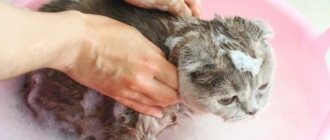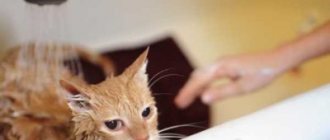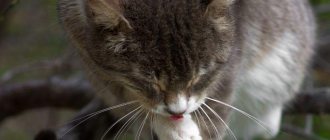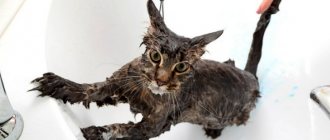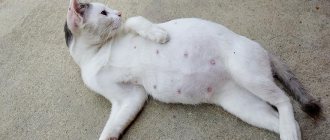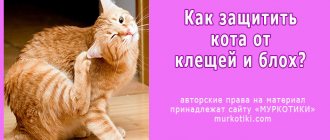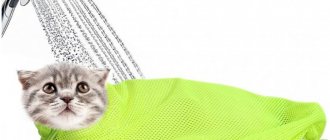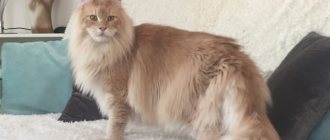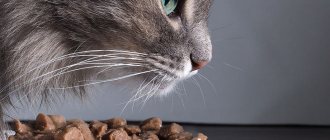Flea shampoos for cats can be found in every pet store. They effectively help against blood-sucking insects, which often cause deterioration in the general condition of a pet. However, it is important to understand which cleaning solution is best for your cat. To do this, you need to understand the varieties, advantages and disadvantages of purchased formulations.
The advisability of bathing
First of all, this is an opportunity to get rid of insects that parasitize a small pet. The active substances that make up industrial sprays, tablets and gels are quite aggressive. The baby’s immunity is just beginning to develop and any poisoning caused by toxic drugs can be fatal.
Bathing a kitten with flea shampoo is the only panacea for blood-sucking parasites. Therapeutic water procedures are especially important for purebred cats, for example, Scottish or British, because they have a very difficult time being around these insects.
Bathing
For reference! Some cat breeds love to swim and enjoy spending time in the water. Among them are Maine Coons, Bobtails, Egyptian Mau and Bengal cats.
Features of the life activity of fleas on the skin of animals
Cats' thick fur with an insulating undercoat traps warm air directly against the skin. A favorable temperature environment is created for the life and reproduction of fleas.
If your cat scratches its ears frequently, this may be a sign that it has fleas.
Fleas are attracted to body heat, vibrations from movement, and the smell of the cat. Dormant larvae quickly “come to life”, quickly turn into fleas, and then jump on the animal.
The presence of fleas in a cat is confirmed by the following symptoms
Fleas are the most common type of flightless blood-sucking parasite.
- Dullness and hair loss.
- Scratching and excessive licking of the fur (it is constantly disheveled) is a sign of flea dermatitis. A flea allergy is a reaction to a substance in flea saliva that prevents blood clotting.
- Numerous peeling flakes of skin, sometimes with a bloody stain around the edges.
- Intraepidermal hemorrhages. If you spread the fur with your hands and look at the condition of the skin, you will see distinct dark red lesions on a white background. In advanced cases, dark red scabs appear, the skin becomes covered with cracks and ulcers.
- A specific sign of fleas is the presence of insects or their metabolic products in the form of black spots (dots) on the skin. More often they are localized in the area of the hind legs (the so-called “panties”) and the back.
Flea bites cause pain and itching to an animal.
Additional pathogens and infections carried by fleas
- Yersinia, salmonella (affect the intestines);
- pseudotuberculosis;
- tularemia and brucellosis (especially dangerous infections);
- tick-borne encephalitis virus;
- trypanosomes.
Contraindications
Despite the apparent safety of this enterprise, it has a number of contraindications. The critical point is age. Under no circumstances should kittens under 3 months of age be allowed to participate in water procedures. During the washing process, skin lubricant dissolves, which opens up wide possibilities for dermatitis and other skin problems.
Swimming restrictions:
- Disease . If the kitten is sick (problems with the gastrointestinal tract, helminths, lichen, infections, etc.), then before bathing you should consult a specialist.
- Vaccination . Your pet should not come into contact with water for two weeks after any vaccinations.
- Surgical intervention . If there are fresh stitches on the body, then water procedures are strictly prohibited.
- Stress . When a cat is psychologically unstable, it cannot be treated with detergents and water. This will only aggravate stress and discourage your pet from water procedures.
At what age can you bathe a kitten?
Is it possible to bathe a kitten that is a week old or a little more? Absolutely not. Babies, unlike adults, are more vulnerable to diseases due to weak, immature immunity. Water violates the integrity of the protective film, which is fraught with the penetration and development of harmful microorganisms, including fleas.
There is no need to wash your pet for the first 2 months of life . All hygiene procedures, as well as cleaning from blood-sucking and other parasites, are undertaken by the kitten’s mother. If for some reason the latter is absent, then procedures can begin at 30 days of age.
At 3 months, the baby will already be stronger and bathing will not cause him any significant harm. Breeders do not recommend postponing the procedure to a later date. The older your pet gets, the more difficult it will be for him to get used to water. So the question: “When can you wash a kitten?” can be answered with confidence - upon reaching 3 months of age.
Processing rules
In order for the procedure to bring the desired result and not cause unnecessary problems for the animal owner, several nuances need to be taken into account:
- Choosing a location. If the level of parasite infestation is high, fleas will move from the animal to surrounding surfaces. Therefore, it is recommended to carry out the procedure outdoors or indoors where there are no other pets. When this is not possible, you should at least protect yourself by treating the room with a strong agent in advance. This measure will reduce the likelihood of fleas spreading.
- Cloth. To avoid parasite bites, you need to cover the most vulnerable parts of the body at this moment.
- Processing items. As a rule, flea eggs and larvae are found on surfaces with which the pet is most often in contact. To prevent re-infestation, you also need to apply special products to them, and you should place a bag filled with pine sawdust under the cat’s house or bed - this will repel parasites.
- Animal processing. Fleas tend to spread to other inhabitants of the apartment. Therefore, if the owner has several pets, he will need to take preventive measures, which involve the use of means to combat parasites even on healthy animals.
The washing process itself should not cause difficulties, because if the kitten does not like water, it will be easy to hold it together. The main thing is to carefully read the instructions for the shampoo, especially highlighting the exposure time of the product and the interval before the next treatment. Otherwise, the general recommendations are:
Place the kitten in a plastic basin. It is advisable to do this in a similar container, since due to the small size of the animal, it will be a little difficult to process in the bath. However, this option is also allowed, but the bottom of the tub will have to be covered with a rag so that the pet’s paws do not slip on the enamel. Thoroughly wet the kitten's fur and lather, starting from the neck area
This is important because this way the parasites will not move from the body to the face. Leave the soap mass for the time period specified in the instructions. The kitten must be restrained so that it does not lick the product
The main thing is not to be afraid of causing pain to the animal and to be careful. Rinse off the shampoo (until there is no foam). At the same time, it is worth manually picking out fleas from the kitten’s face, if any remain on it.
To increase efficiency, wet wool should be combed with a fine-tooth comb. This step may slightly spoil its appearance, but will have a positive effect on the result.
If your animal becomes irritated after applying the shampoo, the product should be washed off immediately. To avoid trouble, you should consult a veterinarian. It is also recommended to do this if the owner is not sure of the choice
Such precautions will allow you to get the best effect from the treatment and protect the animal.
How often to wash?
Too frequent procedures deteriorate the quality of the coat. It is necessary to treat a kitten for fleas taking into account its breed, the specificity of its hair coat and its state of health. When it comes to pets that do not leave the apartment, they need to be bathed approximately 6 times a year .
Important! If fleas or worms appear, the procedure should be carried out immediately, even if the last contact with water was very recent.
As such, there are no restrictions in cats with little or no fur, like Sphynxes or Abyssinian cats. They get dirty noticeably faster, so the frequency of their bathing is reduced to once a month .
Review and characteristics of shampoos
Most often on the shelves of retail outlets offering shampoos for cats are the products “Phytoelita”, “Mr. Kiss", "Bars".
Phytoelite
The shampoo has a paralyzing effect on parasites, which causes their death.
The drug is available in two types, for adult animals and for kittens, in 220 ml plastic bottles. The price of packaging in Russia ranges from 80-110 rubles.
A special feature is the reduced processing time for wool.
It takes 5 minutes instead of 10-15 for other shampoos.
Buy shampoo only in specialized stores or veterinary pharmacies to protect yourself from purchasing counterfeits.
Barsik
One of the most famous shampoos from Russian manufacturers. It contains the drug permethrin, which accumulates under the skin of a cat and, when bitten, causes neuromuscular paralysis in the parasites. The drug is completely harmless to the animal.
Available in 200 ml bottles. The average price ranges from 40 to 60 rubles. Due to its gentle composition, it can be used more often than other shampoos. Does not harm the animal's fur and promotes rapid healing of the bite site.
Now an improved version of this shampoo called “Bars” has appeared. It is distinguished by a more optimized composition and the presence of essential oils in the detergent, which prevent hair from tangling even in long-haired cats.
Attention: the composition of the shampoo cannot be called completely harmless, so before use, carefully read the instructions on the product packaging. You can learn more about Bars shampoos and other flea and tick products for cats here
You can learn more about Bars shampoos and other flea and tick products for cats here.
Lugovoy
According to reviews received from cat owners, the drug is very effective. The composition contains, in addition to insecticides, extracts from medicinal herbs. Helps normalize your pet's skin metabolism. Has high cleaning power when using water of any hardness.
Shampoo packaging is polymer, volume 250 ml. The detergent is presented for sale both in specialized stores and in veterinary pharmacies. Price range from 120 to 150 rubles.
Celandine
In addition to permethrin, this shampoo contains another insecticide. This is fipronil.
Due to the use of two drugs it is very effective. Contains substances that do not irritate the mucous membranes of your pets.
The application does not differ due to the age of the animal, and is also suitable for dogs. Available in 180 ml polymer bottles, average price 75-90 rubles.
Important: treatment guarantees the destruction of fleas on the cat, but does not protect against re-infection. Use flea prevention products
Mr. Kiss
The shampoo contains innovative developments from Swiss veterinarians that do not irritate the skin and mucous membranes of cats.
The detergent is available in 200 ml bottles.
Composition two in one. Contains not only shampoo, but also conditioner that helps eliminate dry cat skin and makes it easy to comb the animal's fur. The price of packaging in Russia ranges from 130 to 180 rubles.
BioVax
An effective product that kills not only fleas, but also ticks.
Veterinarians advise using shampoo together with sprays or drops to prevent re-infections of cats.
Available in 210 ml polymer bottles.
The average price is in the range of 100-140 rubles.
On our Internet portal you will find recommendations from our experts on the use of various products for adult animals and kittens, and also learn how to use tar soap and the drugs Frontline, Advocate, Advantage, Stronghold, Inspector to combat cat fleas.
Before purchasing shampoo, consult with specialists. This takes into account the age, condition of the animal, as well as the degree of parasite infestation. Advice from a veterinarian, as well as careful study of the instructions, will help not harm your pet and avoid repeated flea infestations.
Detergents
Regular soaps or shampoos will not work for humans. The kitten needs special products for bathing, and in case of flea infestation - containing active substances of a medical nature. In pet stores and veterinary pharmacies you can always find solutions depending on your situation and your budget.
Shampoos
Popular flea shampoos for kittens:
- Kiss;
- AVZ Elite Organic;
- Api-San;
- Beaphar;
- Lugovoy;
- Leopard.
Shampoo for fleas in cats: which one to choose
When purchasing a therapeutic or prophylactic composition, it is important to focus not only on the reviews of the owners, but also on the recommendations of veterinarians. Pet stores sometimes regularly receive useful new products that the owners don’t know about.
The doctor will tell you which product to buy, taking into account the condition and age of the pet, and the number of parasites.
Leopard
Characteristic:
- destroys ticks and fleas in cats;
- good quality plus reasonable price. , Russia;
- contains not only toxic components, but also extracts of cloves, pelargonium, essential oils of costus, lavender, allantoin;
- active additives improve the condition of the coat, prevent tangles in long-haired breeds, soften the skin of the cat;
- composition for external use is a gel-like liquid, the shade ranges from almost transparent to light yellow;
- volume of the drug – 250 ml;
- shelf life – 1.5 years;
- the average price is 190 rubles.
4 with a tail
Characteristic:
- prophylactic;
- no toxic ingredients;
- active ingredient – citronella oil;
- prevents the penetration of lice, fleas, ixodid and scabies mites, lice mites in cats and dogs;
- disinfects, actively deodorizes, improves the condition of the skin and hair of pets;
- gel-like mass of pleasant green color, specific smell;
- packaging – tubes and polymer bottles, volume – from 160 to 270 ml;
- shelf life – 18 months;
- the average price is 80 rubles.
Phytoelite
Characteristic:
- insecticide for external use in cats and dogs;
- active substance – permethrin 0.3%. A contact-intestinal insecticide disrupts the functioning of organs in parasites, causes paralysis, and rapid death of insects;
- contains decoctions of celandine, wormwood, bischofite, CCP (chlorophyll-carotene paste);
- homogeneous liquid, color from greenish-yellow to brownish-green;
- the drug is approved for treating kitten fur;
- After application, leave the drug on the animal’s body for 5 minutes;
- packaging – polymer bottles with a volume of 100 to 500 ml;
- the composition is valid for 12 months;
- the average cost is from 70 to 100 rubles, depending on the volume.
Lugovoy
Characteristic:
- variety “For cats and dogs” contains the neurotropic poison permethrin and plant components: extract of calendula, chamomile, coltsfoot;
- a variety of shampoo “For cats” contains permethrin, chamomile, dandelion root extract, plantain, lanolin;
- the medicinal composition destroys lice and fleas;
- active ingredients stimulate metabolism in hair follicles and skin;
- under the influence of permethrin, massive death of dangerous parasites was observed;
- herbal extracts give the coat a pleasant shine and silkiness;
- a drug with a slight odor;
- the product does not dry out the skin and coat;
- long-term protection against attack by ectoparasites;
- the average price is 140 rubles for 270 ml.
How to properly bathe a kitten for the first time?
This is an important and responsible moment not only for the baby, but also for his owner. If the kitten does not experience stress the first time, then subsequent procedures will also take place without incidents - dissatisfied meowing and scratched hands.
Important! Breeders advise bathing the baby in a basin, and not in the bathtub. In such conditions it is much easier to hold it, and the pet will feel more confident in a small container.
Bathing process:
- Fill 2 basins with warm water so that it reaches the kitten’s belly.
- We cover the pet's ears with cotton pads, and it is also advisable to wear a harness.
- While stroking the kitten, we lower it into the basin.
- We scoop up the water with our hands and pour it over the baby.
- Add flea shampoo, lather and apply to the coat.
- Rinse the kitten in foam, and then in clean water.
After bathing, you need to wrap your pet in a towel, trying to squeeze out as much moisture as possible from the fur. After a couple of minutes, change it to dry. As soon as the water has drained, you can transfer the kitten to its usual environment - a house or to its mother cat. The latter itself will rid the baby of residual moisture.
Important! You cannot use the shower when bathing your pet. The kitten may be frightened by the strong jet and noise, which will discourage repeated procedures.
"Wet" shampoos
If the cat accepts bathing more or less normally, then it is recommended to wash it with water. To do this, you need to choose the appropriate shampoo.
When choosing a washing product, look at the label: it should indicate that the shampoo is suitable for cats, and also state the purpose, for example, for greater hardness or softness of the coat, for silkiness, for the prevention of tangles, etc. It may also be written on the shampoo that it is more suitable for short-haired animals, or vice versa, for long-haired animals. This should also be taken into account when choosing a drug. There are also shampoos for very oily or very dirty coats, for skin with dandruff, for removing oily stains, etc.
Separately, it is worth highlighting medicated shampoos intended for the treatment of skin diseases and the removal of fleas. They are used only if indicated. By the way, when you carry out prevention rather than treatment of fleas, you can purchase repellent shampoo that repels insects.
If your cat is prone to allergies, she will need a hypoallergenic shampoo. If you want to be more environmentally friendly, choose a shampoo made from natural ingredients, but keep in mind that it cannot be 100% natural, because... all the same, it must contain auxiliary chemicals that prevent the natural ingredients from deteriorating.
Each shampoo has its own characteristics, designed for the age, size and weight of the animal. Therefore, you must strictly follow the instructions. In particular, keep in mind that you can often find so-called concentrated shampoos, which, before spreading on the cat, need to be dripped onto your hand and diluted with water, that is, diluted. In concentrated form, they cause allergic and other reactions.
Basic rules for washing kittens
If you follow a number of simple rules, then during subsequent baths the kitten will experience noticeably less stress.
Recommendations:
- The procedure cannot be carried out immediately after eating.
- It is advisable to wash the kitten during its molting period.
- Before bathing, the coat must be combed and tangled.
- There should be no drafts in the processing area.
- For the first time, it is better to take unscented flea shampoo.
- The temperature in the basin should not exceed +40⁰С and not fall below +37⁰С.
- The head should be wetted with a sponge, not with water from your hand.
During the first bath, an assistant will also help: one person calms the baby, while the other performs all the necessary actions.
Rules of application
Fleas in a person's head die very quickly if you apply and wash off the product correctly and do not forget about precautions. It is worth taking note of the following recommendations:
Up to 60 ml of the drug is usually consumed per person’s head, depending on the length and thickness of the strands. All medications are applied either with a cotton swab or with special gloves: it is strictly forbidden to take them with bare hands
First, the product is applied to some base, and then carefully distributed over the entire head. After application, the head is covered with a plastic cap and wrapped with a towel on top. If shampoo accidentally gets into your eyes, rinse them immediately with plenty of water. All products should be used with open windows and, if possible, in an open space: this way there will be no risk of poisoning with toxic substances, which are one way or another included in all medicinal preparations. After washing, it is important to comb thoroughly with a fine lice comb.. Interesting! There is an opinion that you can walk an animal in the cold and the fleas themselves will freeze
At what temperature do fleas die? Parasites are distinguished by their rare vitality: even at -20 degrees they only fall asleep, lose the ability to reproduce and move, but in the warmth they come to life again and begin to jump with the same energy
Curious! There is an opinion that you can walk an animal in the cold and the fleas themselves will freeze. At what temperature do fleas die? Parasites are distinguished by their rare vitality: even at -20 degrees they only fall asleep, lose the ability to reproduce and move, but in the warmth they come to life again and begin to jump with the same energy.
How to teach a kitten to bathe?
First of all, the owner himself needs to tune in. Cats feel people very subtly and the latter’s excitement is immediately transmitted to the animal. Therefore, before bathing a small kitten, you need to calm down and relax.
In the basin
Before filling the basin with water, you should put your pet in it and play with it so that it gets used to the environment. As soon as the baby gets comfortable, you can pour water. At the same time, it is very important to stroke the kitten, while talking to it in lower tones.
How to dry?
Immediately after bathing, the baby should be wrapped in a terry towel. At the same time, you cannot rub the fur too much, otherwise the hair will become crumpled, and then tangles will form. If the wool is long, you will need several towels.
Afterwards the pet is released: it will lick and comb itself. After bathing, the kitten should stay in a warm room for at least 12 hours. A draft or low temperature is under no circumstances acceptable.
Important! If the baby trembles for more than 5 minutes after bathing, then you should resort to using a hair dryer or heater. In this case, the air flow should not be hot. In parallel with drying, you need to comb your pet.



